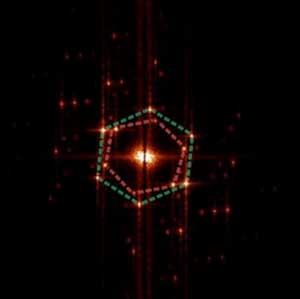| Dec 23, 2019 | |
Researchers break the geometric limitations of moire pattern in graphene heterostructures(Nanowerk News) Researchers at The University of Manchester have uncovered interesting phenomena when multiple two-dimensional materials are combined into van der Waals heterostructures (layered ‘sandwiches’ of different materials). |
|
| These heterostructures are sometimes compared to Lego bricks – where the individual blocks represent different atomically thin crystals, such as graphene, and stacked on top of each other to form new devices. | |
| Published in Science Advances ("Composite super-moiré lattices in double-aligned graphene heterostructures"), the team focus on how the different crystals begin to alter one another’s fundamental properties when brought into such close proximity. | |
 |
|
| Fourier transformation of an AFM image of moiré patterns, showing two sets of distinct hexagonal patterns (red and green dashed hexagons). | |
| Of particular interest is when two crystals closely match and a moiré pattern forms. This moiré pattern has been shown to affect a range of properties in an increasing list of 2D materials. However, typically the geometry of the moiré pattern places a restriction on the nature and size of the effect. | |
| A moiré pattern is due to the mismatch and rotation between the layers of each materials which produces a geometric pattern similar to a kaleidoscope. | |
| The team have broken this restriction by combining moiré patterns into composite ‘super-moiré’ in graphene both aligning to substrate and encapsulation hexagonal boron nitride. | |
| The researchers demonstrate the nature of these composite super-moiré lattices by showing band structure modifications in graphene in the low-energy regime. Furthermore, they suggest that the results could provide new directions for research and devices fabrication. | |
| Zihao Wang and Colin Woods authors of the paper said: “In recent years moiré pattern have allowed the observation of many exciting physical phenomena, from new long-lived excitonic states, Hofstadter’s Butterfly, and superconductivity. | |
| Our results push through the geometric limitation for these systems and therefore present new opportunities to see more of such science, as well as new avenues for applications.” |
| Source: University of Manchester | |
|
Subscribe to a free copy of one of our daily Nanowerk Newsletter Email Digests with a compilation of all of the day's news. |
